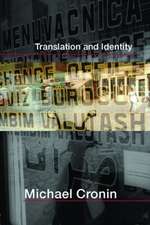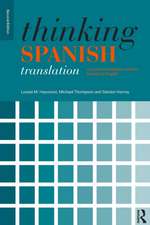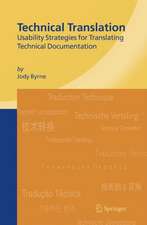Scientific and Technical Translation Explained: A Nuts and Bolts Guide for Beginners: Translation Practices Explained
Autor Jody Byrneen Limba Engleză Paperback – 20 mar 2012
Scientific and Technical Translation Explained provides an overview of the main features of scientific and technical discourse as well as the different types of documents produced. A series of detailed case studies highlight various translation challenges and introduce a range of strategies for dealing with them. A variety of resources and exercises are included to make learning effective and enjoyable. Additional resources and activities are available on Facebook.
Din seria Translation Practices Explained
-
 Preț: 303.87 lei
Preț: 303.87 lei -
 Preț: 302.16 lei
Preț: 302.16 lei -
 Preț: 265.72 lei
Preț: 265.72 lei -
 Preț: 233.92 lei
Preț: 233.92 lei -
 Preț: 280.81 lei
Preț: 280.81 lei -
 Preț: 288.80 lei
Preț: 288.80 lei -
 Preț: 309.50 lei
Preț: 309.50 lei -
 Preț: 228.76 lei
Preț: 228.76 lei -
 Preț: 289.61 lei
Preț: 289.61 lei -
 Preț: 346.94 lei
Preț: 346.94 lei - 18%
 Preț: 1058.65 lei
Preț: 1058.65 lei -
 Preț: 287.04 lei
Preț: 287.04 lei -
 Preț: 259.39 lei
Preț: 259.39 lei -
 Preț: 349.91 lei
Preț: 349.91 lei - 17%
 Preț: 271.43 lei
Preț: 271.43 lei -
 Preț: 279.69 lei
Preț: 279.69 lei -
 Preț: 465.91 lei
Preț: 465.91 lei - 5%
 Preț: 323.58 lei
Preț: 323.58 lei -
 Preț: 290.36 lei
Preț: 290.36 lei -
 Preț: 410.50 lei
Preț: 410.50 lei -
 Preț: 380.36 lei
Preț: 380.36 lei -
 Preț: 362.82 lei
Preț: 362.82 lei - 17%
 Preț: 246.74 lei
Preț: 246.74 lei - 22%
 Preț: 371.87 lei
Preț: 371.87 lei -
 Preț: 443.69 lei
Preț: 443.69 lei - 13%
 Preț: 321.08 lei
Preț: 321.08 lei -
 Preț: 367.23 lei
Preț: 367.23 lei -
 Preț: 395.85 lei
Preț: 395.85 lei
Preț: 246.96 lei
Preț vechi: 296.10 lei
-17% Nou
Puncte Express: 370
Preț estimativ în valută:
47.25€ • 49.47$ • 39.10£
47.25€ • 49.47$ • 39.10£
Carte tipărită la comandă
Livrare economică 07-21 aprilie
Preluare comenzi: 021 569.72.76
Specificații
ISBN-13: 9781905763368
ISBN-10: 1905763360
Pagini: 246
Ilustrații: illustrations
Dimensiuni: 174 x 246 x 15 mm
Greutate: 0.43 kg
Ediția:1
Editura: Taylor & Francis
Colecția Routledge
Seria Translation Practices Explained
Locul publicării:Oxford, United Kingdom
ISBN-10: 1905763360
Pagini: 246
Ilustrații: illustrations
Dimensiuni: 174 x 246 x 15 mm
Greutate: 0.43 kg
Ediția:1
Editura: Taylor & Francis
Colecția Routledge
Seria Translation Practices Explained
Locul publicării:Oxford, United Kingdom
Public țintă
Postgraduate and UndergraduateCuprins
1. Scientific and Technical Translation
1.1 Introduction
1.1.1 Some distinctions
1.1.2 Historical significance
1.1.3 Modern scientific and technical translation
1.1.4 Some legal dimensions
1.2 A place for translation theory?
1.2.1 Recreating the source text
1.2.2 Focusing on the target text
1.3 Tools of the trade
1.3.1 General tools
1.3.2 Text processing tools
1.3.3 Translation tools
1.4 Who’s who in scientific and technical translation?
1.4.1 The translator
1.4.2 The clients
2. Translation and Technical Communication
2.1 Introduction
2.2 What is technical communication?
2.2.1 Generic features of technical communication
2.3 Who reads technical documentation?
2.3.1 Understanding audiences
2.3.2 Finding out who the audience is
2.3.2.1 Asking the right questions
2.4 Knowing what you’re talking about
3. Understanding Technical Documentation
3.1 Introduction
3.1.1 Specific features of technical documentation
3.1.1.1 Language
3.1.1.2 Facts and specifications
3.1.1.3 References
3.1.1.4 Graphics
3.1.1.5 Formulae, equations and scientific notation
3.2 Typical text types
3.2.1 Manuals
3.2.2 Applications and proposals
3.2.3 Reports and scientific papers
3.2.4 Presentations
3.2.5 Regulatory documents
3.2.6 Popular science
3.2.7 A word on how texts are structured
3.2.8 Making sense of text types in translation
4. Case Studies
4.1 Introduction
4.2 Scientific Journal Paper
4.3 Technical Data Sheet (TDS)
4.4 Creating your own document profiles
4.4.1 Document Profile Sheet
4.5 Test Instructions
4.6 Expert Technical Report
4.7 User Guide
4.8 Popular Science Book
4.9 Certificate of Conformity
4.10 Technical Case Study
5. Basic Translation Techniques
5.1 Introduction
5.2 The basics
5.2.1 Direct translation
5.2.1.1 Literal translation
5.2.1.2 Borrowing
5.2.1.3 Calque
5.2.2 Oblique translation
5.2.2.1 Equivalence
5.2.2.2 Transposition/Recategorization
5.2.2.3 Modulation
5.2.2.4 Adaptation
5.2.3 Expansion and contraction
5.2.3.1 Recycling information
5.2.4 Generalizing and particularizing
5.2.5 Compensation
5.2.6 Restructuring
5.2.7 Iconic Linkage
5.3 What type of translation are you producing?
5.3.1 Instrumental and documentary translations
5.3.2 Producing a translation brief
5.3.3 When not to translate
5.3.3.1 Official translations and proper names
5.3.3.2 Laws
5.3.3.3 European Directives
5.4 Writing within limits
5.4.1 Terminology
5.4.2 Clarity, readability and usability
5.4.3 Editing and proof-reading
5.4.3.1 Reviewing the work of another translator
5.4.3.2 General hints for editing and reviewing translations
5.5 When in doubt
6. Pitfalls, Problems and How to Deal with Them
6.1 Introduction
6.2 Abbreviations and acronyms
6.3 Formulae and Equations
6.4 Quantities and units of measure
6.5 Currencies
6.6 Culture and Familiarity
6.7 Errors in the Source Text
6.8 Sample text and computer code
6.9 Graphics, screenshots and menus
6.10 Product names
6.11 Contact details
6.12 Scenarios and examples
6.13 Giving warnings and advice
6.14 References to other documents
6.15 Partially translated source texts
6.16 Latinisms and scientific nomenclatures
6.17 Instructions that do not make sense
6.18 Tables of contents and indices
6.19 Formatting and layout
6.20 Managing and naming files
6.21 Using the Internet
1.1 Introduction
1.1.1 Some distinctions
1.1.2 Historical significance
1.1.3 Modern scientific and technical translation
1.1.4 Some legal dimensions
1.2 A place for translation theory?
1.2.1 Recreating the source text
1.2.2 Focusing on the target text
1.3 Tools of the trade
1.3.1 General tools
1.3.2 Text processing tools
1.3.3 Translation tools
1.4 Who’s who in scientific and technical translation?
1.4.1 The translator
1.4.2 The clients
2. Translation and Technical Communication
2.1 Introduction
2.2 What is technical communication?
2.2.1 Generic features of technical communication
2.3 Who reads technical documentation?
2.3.1 Understanding audiences
2.3.2 Finding out who the audience is
2.3.2.1 Asking the right questions
2.4 Knowing what you’re talking about
3. Understanding Technical Documentation
3.1 Introduction
3.1.1 Specific features of technical documentation
3.1.1.1 Language
3.1.1.2 Facts and specifications
3.1.1.3 References
3.1.1.4 Graphics
3.1.1.5 Formulae, equations and scientific notation
3.2 Typical text types
3.2.1 Manuals
3.2.2 Applications and proposals
3.2.3 Reports and scientific papers
3.2.4 Presentations
3.2.5 Regulatory documents
3.2.6 Popular science
3.2.7 A word on how texts are structured
3.2.8 Making sense of text types in translation
4. Case Studies
4.1 Introduction
4.2 Scientific Journal Paper
4.3 Technical Data Sheet (TDS)
4.4 Creating your own document profiles
4.4.1 Document Profile Sheet
4.5 Test Instructions
4.6 Expert Technical Report
4.7 User Guide
4.8 Popular Science Book
4.9 Certificate of Conformity
4.10 Technical Case Study
5. Basic Translation Techniques
5.1 Introduction
5.2 The basics
5.2.1 Direct translation
5.2.1.1 Literal translation
5.2.1.2 Borrowing
5.2.1.3 Calque
5.2.2 Oblique translation
5.2.2.1 Equivalence
5.2.2.2 Transposition/Recategorization
5.2.2.3 Modulation
5.2.2.4 Adaptation
5.2.3 Expansion and contraction
5.2.3.1 Recycling information
5.2.4 Generalizing and particularizing
5.2.5 Compensation
5.2.6 Restructuring
5.2.7 Iconic Linkage
5.3 What type of translation are you producing?
5.3.1 Instrumental and documentary translations
5.3.2 Producing a translation brief
5.3.3 When not to translate
5.3.3.1 Official translations and proper names
5.3.3.2 Laws
5.3.3.3 European Directives
5.4 Writing within limits
5.4.1 Terminology
5.4.2 Clarity, readability and usability
5.4.3 Editing and proof-reading
5.4.3.1 Reviewing the work of another translator
5.4.3.2 General hints for editing and reviewing translations
5.5 When in doubt
6. Pitfalls, Problems and How to Deal with Them
6.1 Introduction
6.2 Abbreviations and acronyms
6.3 Formulae and Equations
6.4 Quantities and units of measure
6.5 Currencies
6.6 Culture and Familiarity
6.7 Errors in the Source Text
6.8 Sample text and computer code
6.9 Graphics, screenshots and menus
6.10 Product names
6.11 Contact details
6.12 Scenarios and examples
6.13 Giving warnings and advice
6.14 References to other documents
6.15 Partially translated source texts
6.16 Latinisms and scientific nomenclatures
6.17 Instructions that do not make sense
6.18 Tables of contents and indices
6.19 Formatting and layout
6.20 Managing and naming files
6.21 Using the Internet
Descriere
Scientific and Technical Translation Explained provides an overview of the main features of scientific and technical discourse as well as the different types of documents produced.








